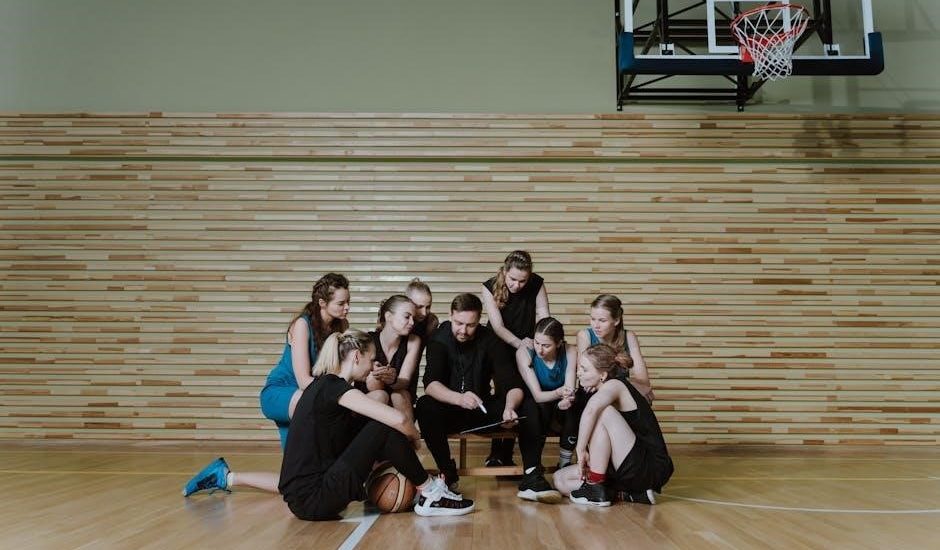Pip Decks Team Tactics offers a comprehensive guide to enhancing workplace communication and collaboration, focusing on influence, critical thinking, and effective leadership strategies to drive team success.
1.1 What Are Pip Decks?
Pip Decks are strategic resources designed to enhance team collaboration and communication. They provide actionable insights and tools for effective problem-solving, decision-making, and leadership. Focused on workplace dynamics, Pip Decks emphasize the importance of influence, critical thinking, and emotional intelligence. The guides are tailored to help teams navigate challenges, fostering a culture of innovation and mutual respect. By leveraging the Colin James Method, Pip Decks offer a structured approach to improving team performance and achieving shared goals. They are widely recognized for their practical, real-world applications in various professional settings.
1.2 Overview of Team Tactics Guide
The Team Tactics guide by Pip Decks is a detailed resource designed to improve team performance through effective communication, collaboration, and problem-solving strategies. It focuses on fostering influence, critical thinking, and emotional intelligence within workplace dynamics. The guide emphasizes practical applications of these strategies, providing teams with actionable tools to enhance decision-making and leadership skills. By addressing real-world challenges, the guide equips teams with the knowledge to apply these tactics effectively, ensuring improved outcomes and a more cohesive work environment.
1.3 Importance of Effective Team Collaboration
Effective team collaboration is essential for achieving alignment, fostering innovation, and ensuring collective success. It promotes a culture of trust, respect, and open communication, enabling teams to leverage diverse perspectives and skills. Collaboration enhances problem-solving, decision-making, and adaptability, while reducing conflicts and inefficiencies. The Pip Decks guide emphasizes that strong collaboration is rooted in influence, active listening, and emotional intelligence, ultimately driving teams to achieve their full potential and deliver impactful results in dynamic work environments.
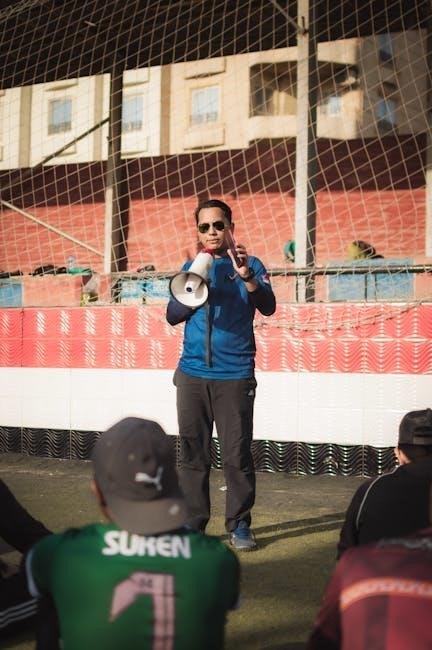
Key Components of Pip Decks Team Tactics
Pip Decks Team Tactics includes communication strategies, influence techniques, and problem-solving methods to enhance collaboration and decision-making, supported by critical thinking and the Colin James Method.
2.1 Communication Strategies
Pip Decks Team Tactics emphasizes effective communication as the backbone of successful team collaboration. It explores strategies for clear verbal and non-verbal exchanges, fostering active listening, and ensuring clarity in messaging. The guide highlights the importance of adapting communication styles to different audiences and contexts, while maintaining professionalism and empathy. By focusing on concise and impactful expression, teams can avoid misunderstandings and align their efforts toward shared goals. These strategies are designed to enhance transparency, trust, and overall team cohesion, leading to improved productivity and collaboration.
2.2 Influence in the Workplace
Pip Decks Team Tactics highlights the importance of influence as a key driver of team success. It explores how individuals can shape opinions, guide decisions, and inspire action within their teams. The guide emphasizes techniques such as persuasion, emotional intelligence, and leading by example. By understanding how to leverage influence effectively, team members can foster alignment, build trust, and drive collective progress. This section provides practical strategies to enhance personal and professional influence, empowering individuals to contribute meaningfully to their team’s objectives and outcomes.
2.3 Problem-Solving Techniques
Pip Decks Team Tactics emphasizes effective problem-solving as a cornerstone of successful teamwork. It outlines structured approaches to identify, analyze, and resolve challenges. Techniques include brainstorming, mind mapping, and SWOT analysis. The guide advocates for collaboration and critical thinking to ensure creative and practical solutions. By fostering a culture of open dialogue and constructive feedback, teams can tackle complexities efficiently. These methods help teams align on priorities, address obstacles, and implement actionable plans to achieve their goals effectively.
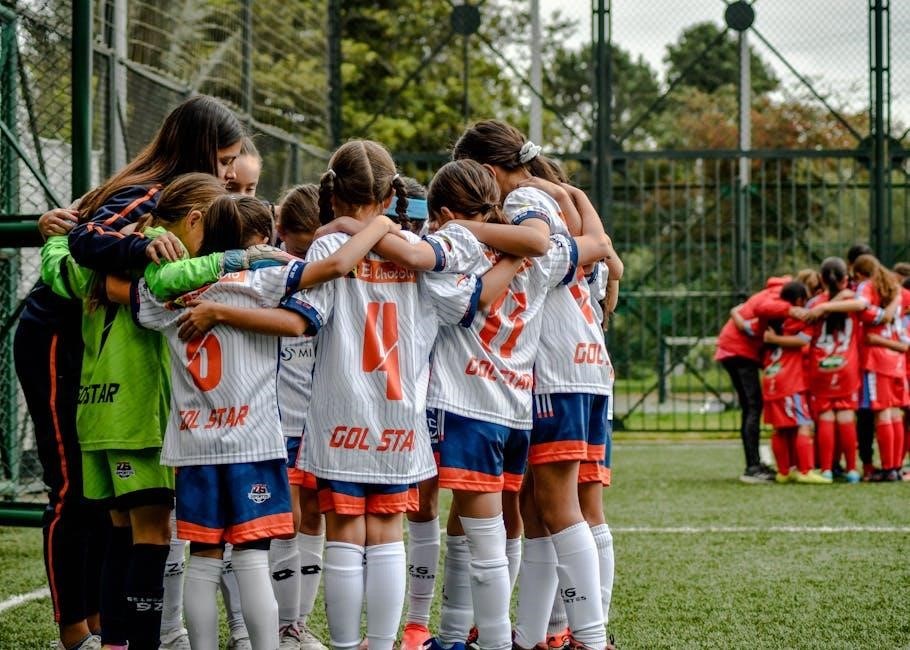
Understanding Team Collaboration
Team collaboration involves aligning individual strengths, fostering trust, and promoting open communication to achieve shared goals. It requires mutual respect and a collective commitment to success.
3.1 The Role of Influence in Team Dynamics
Influence plays a crucial role in shaping team dynamics by enabling individuals to inspire, guide, and align others toward common objectives. It fosters collaboration, builds trust, and enhances decision-making processes. Effective influence ensures diverse perspectives are considered, promoting a balanced approach to problem-solving. When team members exert positive influence, it strengthens cohesion and drives collective success. However, excessive influence can lead to dominance, stifling creativity. Striking the right balance is key to maintaining productive and inclusive team environments, as emphasized in the Pip Decks Team Tactics guide.
3.2 How to Form Opinions and Make Decisions
Forming opinions and making decisions in a team requires active listening, critical thinking, and collaboration. Encourage open discussions to gather diverse perspectives and use structured decision-making frameworks to evaluate options. Foster an environment where team members feel comfortable sharing their views. Consensus-building techniques ensure collective buy-in, while accountability measures guarantee decisions are implemented effectively. Pip Decks Team Tactics emphasizes the importance of balancing individual insights with team alignment to achieve cohesive and impactful outcomes. This approach enhances both the quality and acceptance of decisions within the group.
3.3 Thinking and Reasoning in a Team Context
Thinking and reasoning in a team context involve critical thinking, logical reasoning, and collaborative problem-solving. Teams should analyze data, evaluate arguments, and consider multiple perspectives to make informed decisions. Encourage creative brainstorming and structured approaches to address challenges. Pip Decks Team Tactics emphasizes the importance of reducing biases and assumptions through systematic reasoning. By fostering a culture of intellectual curiosity and constructive debate, teams can enhance their analytical capabilities and deliver well-rounded solutions that align with shared goals and priorities.

Communication Techniques
Effective communication techniques enhance team collaboration, ensuring clear exchanges of ideas. Focus on verbal and non-verbal cues, active listening, and conflict resolution strategies to foster understanding.
4.1 Verbal and Non-Verbal Communication
Effective communication combines verbal and non-verbal elements. Verbal communication involves clear, concise spoken words, while non-verbal cues like body language, facial expressions, and eye contact convey emotions. Both are crucial for conveying messages accurately and building trust within teams; Understanding these elements helps align intentions with interpretations, reducing misunderstandings. The Pip Decks Team Tactics PDF emphasizes mastering these skills to enhance collaboration and ensure seamless interaction among team members, fostering a productive and harmonious work environment.
4.2 Active Listening and Feedback
Active listening and constructive feedback are vital for effective team communication. Active listening involves fully engaging with the speaker, understanding their message, and showing empathy. Feedback, when delivered thoughtfully, helps team members grow and improve. The Pip Decks Team Tactics PDF highlights the importance of balancing positive reinforcement with constructive criticism. This fosters a culture of openness, trust, and continuous improvement, ensuring teams can address issues promptly and collaboratively. Regular, meaningful feedback loops enhance performance and align team efforts with shared goals.
4.3 Conflict Resolution Strategies
Conflict resolution is crucial for maintaining harmony and productivity within teams. The Pip Decks Team Tactics PDF emphasizes strategies like staying calm, identifying conflict triggers, and fostering open dialogue. Active listening and empathy help parties understand differing perspectives. Focusing on solutions rather than blame encourages collaboration. Techniques such as mediation and compromise can resolve disputes effectively. By addressing conflicts promptly and constructively, teams can strengthen relationships, enhance trust, and create a more positive work environment. Effective conflict resolution fosters resilience and aligns the team with shared objectives.

Problem-Solving and Decision-Making
This section focuses on enhancing critical thinking, encouraging collaborative problem-solving, and using structured methods to make informed decisions, ensuring effective strategies for team success.
5.1 Critical Thinking in Teams
Critical thinking is essential for teams to make informed decisions and solve complex problems. Pip Decks Team Tactics emphasizes the importance of encouraging objective analysis and logical reasoning. By fostering a culture of critical thinking, teams can identify biases, evaluate evidence, and develop well-reasoned solutions. This approach ensures that decisions are based on clarity of thought and alignment with shared goals, leading to more effective outcomes and enhanced collaboration.
5.2 Deliberation and Speculation in Decision-Making
Deliberation and speculation are vital in team decision-making, as they encourage thorough discussion and exploration of possibilities. Pip Decks Team Tactics highlights the importance of deliberate debate to ensure all perspectives are considered. Speculation allows teams to anticipate outcomes and potential risks, fostering proactive planning. By combining these approaches, teams can make more informed decisions and adapt to challenges effectively. This balanced method ensures that decisions are both strategic and aligned with long-term goals, enhancing overall team performance and success.
5.3 Using Collaboration Tools for Problem-Solving
Collaboration tools play a crucial role in enhancing problem-solving within teams. Pip Decks Team Tactics emphasizes the use of platforms like Slack, Trello, or Asana to streamline communication and task management. These tools foster real-time collaboration, ensuring all team members are aligned and contribute effectively. By leveraging these resources, teams can organize ideas, track progress, and brainstorm solutions collectively. Collaboration tools not only boost productivity but also enable teams to approach challenges with a unified and structured mindset, leading to more innovative and effective solutions.

Influence and Persuasion
Influence and persuasion are vital for aligning teams toward common goals. Strategic communication, emotional intelligence, and ethical techniques foster trust and drive collective success in collaborative environments.
6.1 The Power of Persuasion in Teams
Persuasion is a cornerstone of effective leadership and collaboration. It enables individuals to align team members toward shared objectives by leveraging logical arguments, emotional appeal, and credibility.
When applied ethically, persuasion fosters trust and respect, driving collective success. The Pip Decks Team Tactics PDF highlights strategies to enhance persuasive skills, emphasizing clarity, empathy, and strategic communication. By mastering persuasion, leaders can inspire action, resolve conflicts, and steer teams toward achieving their full potential in a harmonious and goal-oriented environment.
6.2 How to Build Influence in the Workplace
Building influence in the workplace involves fostering trust, credibility, and relatability. Consistency in actions and words is key, as it establishes reliability.
Active listening and showing genuine interest in others’ perspectives can strengthen connections. The Pip Decks Team Tactics guide highlights the importance of leading by example and aligning actions with shared goals. By demonstrating expertise and empathy, individuals can naturally gain influence, creating a positive impact on team dynamics and decision-making processes. This approach cultivates a collaborative culture where trust and respect thrive.
6.3 The Colin James Method Explained
The Colin James Method is a structured approach to building influence and improving workplace interactions. It focuses on understanding human behavior, communication, and emotional intelligence to drive effective collaboration. By aligning actions with shared goals and fostering trust, individuals can enhance their impact. The method emphasizes active listening, empathy, and clarity in communication. It also provides practical strategies for navigating conflicts and influencing decisions. This approach, as outlined in the Pip Decks guide, helps individuals cultivate stronger relationships and achieve greater success in team environments.
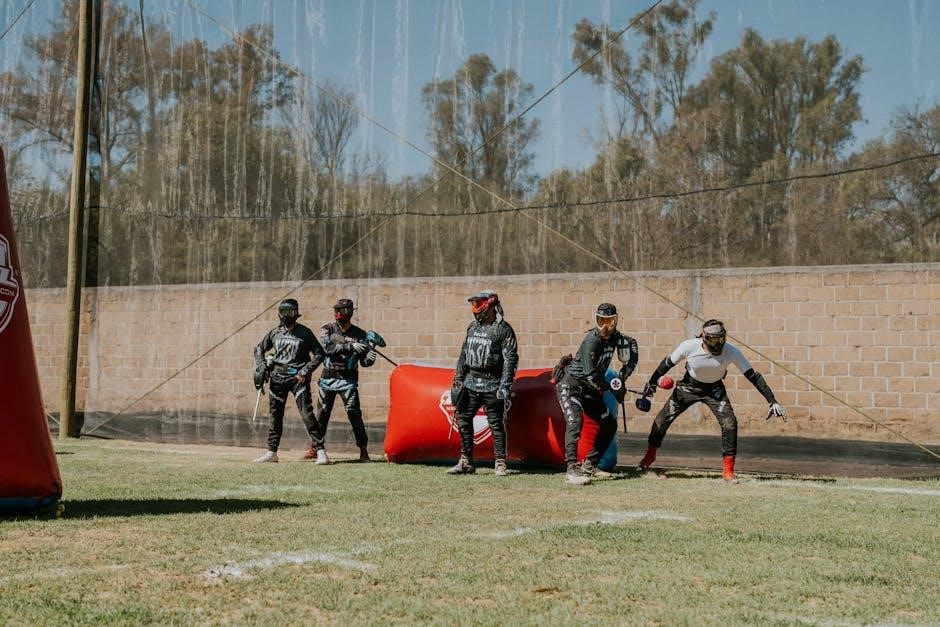
The Colin James Method
The Colin James Method enhances workplace effectiveness by fostering influence, collaboration, and leadership. It equips teams with strategies to improve communication and drive successful outcomes collectively.
7.1 What is the Colin James Method?
The Colin James Method is a structured approach to enhancing workplace effectiveness by fostering influence, leadership, and collaboration. It provides practical strategies to improve communication, decision-making, and team dynamics. Designed to help individuals and teams build stronger relationships, the method emphasizes understanding human behavior, leveraging emotional intelligence, and applying persuasive techniques to achieve alignment and drive results.
7.2 Applying the Method in Team Settings
Applying the Colin James Method in team settings involves practical strategies to enhance collaboration and influence. Teams can use its principles to clarify roles, align goals, and improve decision-making processes. By fostering open communication and active listening, teams build trust and accountability. The method also encourages leveraging emotional intelligence to navigate conflicts and motivate team members. Regular feedback loops and iterative improvement are key to sustaining progress. When integrated with Pip Decks, it provides a structured framework for teams to achieve their objectives effectively.
7.3 Benefits of the Colin James Approach
The Colin James Approach offers numerous benefits, enhancing team dynamics and productivity. It fosters clear communication, aligns team goals, and strengthens individual influence. By promoting emotional intelligence and strategic thinking, it helps teams navigate challenges effectively. The approach also encourages accountability and adaptability, ensuring sustained growth. When combined with Pip Decks, it provides actionable strategies for real-world application, making it a valuable resource for teams aiming to elevate their collaboration and performance.
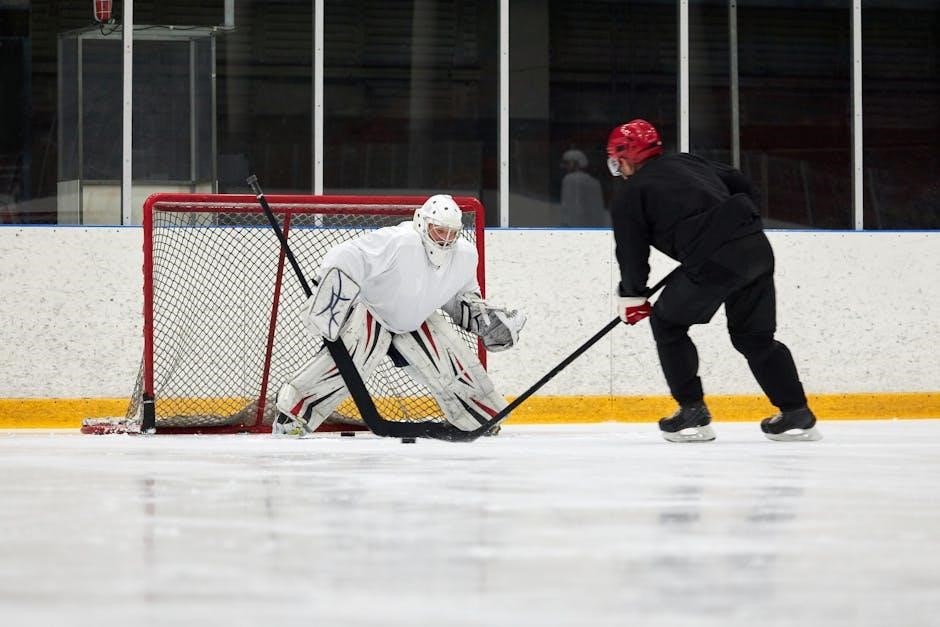
Maximizing Team Potential
Maximizing team potential involves unlocking individual strengths, fostering innovation, and aligning goals with strategic execution. Pip Decks provides actionable strategies to enhance collaboration, creativity, and accountability, ensuring teams thrive and achieve exceptional results.
8.1 Encouraging Creative Thinking
Encouraging creative thinking within teams involves fostering an environment where innovation thrives. Pip Decks provides strategies to stimulate brainstorming, mind mapping, and idea generation. By promoting diverse perspectives and reducing fear of judgment, teams can unlock unique solutions. Leaders should encourage experimentation and learning from failures, nurturing a culture where creativity is valued. The Pip Decks guide offers practical exercises to enhance imaginative problem-solving, ensuring teams produce innovative outcomes consistently. These methods help teams adapt and excel in dynamic environments, driving success through original thinking and collaboration.
8.2 Fostering a Collaborative Environment
Fostering a collaborative environment requires building trust, encouraging open communication, and promoting teamwork. Pip Decks emphasizes the importance of transparency and respect among team members. By establishing clear communication channels and actively listening to diverse perspectives, teams can align their goals and work cohesively. Defining roles and responsibilities also helps minimize conflicts and ensures accountability. Encouraging shared problem-solving and celebrating collective successes further strengthens collaboration, creating a culture where everyone feels valued and empowered to contribute meaningfully.
8.3 The Role of Leadership in Team Success
Leadership plays a pivotal role in driving team success by setting a clear vision, motivating members, and fostering accountability. Effective leaders empower teams by delegating tasks, providing constructive feedback, and making informed decisions. Pip Decks highlights the importance of leaders who inspire trust and create an environment where innovation thrives. Strong leadership ensures alignment with organizational goals, resolves conflicts, and maintains focus on shared objectives. By guiding with clarity and confidence, leaders unlock their team’s full potential, ensuring sustainable success and growth.

Wealth of Knowledge in Team Tactics
Pip Decks emphasizes the importance of financial, social, and emotional wealth in enhancing team performance and fostering collaborative success.
9.1 Financial Wealth and Team Performance
Financial wealth plays a crucial role in team performance by providing resources, motivation, and stability. Pip Decks highlights how effective financial management can enhance productivity and goal achievement. By allocating resources strategically, teams can invest in training, tools, and initiatives that drive success. Financial health also fosters a positive work environment, reducing stress and increasing morale. Pip Decks offers practical strategies to optimize financial wealth, ensuring teams are well-equipped to achieve their objectives and sustain long-term growth.
9.2 Social Wealth and Networking
Social wealth is a vital component of team success, emphasizing the importance of strong relationships and networks. Pip Decks Team Tactics PDF highlights how networking fosters collaboration, trust, and open communication. By building robust connections, teams gain access to diverse perspectives, enhancing problem-solving and innovation. Effective networking also promotes a culture of mutual support, where ideas and resources are shared freely. Pip Decks provides strategies to cultivate social wealth, ensuring teams thrive through meaningful connections and collective growth, leading to sustained success and resilience.
9.3 Emotional Wealth and Team Dynamics
Emotional wealth plays a crucial role in fostering a positive and productive team environment. It involves understanding and managing emotions to enhance collaboration and empathy among members. Pip Decks Team Tactics PDF emphasizes the importance of emotional intelligence in building resilient teams. By addressing emotional needs, teams can navigate conflicts effectively and maintain harmony. The guide provides practical strategies to cultivate emotional wealth, ensuring that team dynamics remain strong and supportive, leading to increased job satisfaction and overall success.

Practical Applications
Practical applications of Pip Decks Team Tactics involve applying strategies to real-world scenarios, enhancing team efficiency and addressing workplace challenges effectively.
10.1 Real-World Examples of Team Tactics
Real-world examples of team tactics include case studies from various industries, such as tech, healthcare, and retail, demonstrating how Pip Decks strategies improve collaboration. For instance, a marketing team used Pip Decks to streamline communication, reducing project timelines by 30%. Another example is a sales team that applied influence techniques to enhance client relationships, boosting revenue by 20%. These examples highlight how practical implementation of Pip Decks Team Tactics can lead to measurable success and improved workplace dynamics.
10.2 Case Studies of Successful Teams
Case studies highlight teams that achieved remarkable results using Pip Decks strategies. A software development team reduced bug rates by 40% through improved communication. A retail team enhanced inventory management, cutting costs by 25%. Another example is a nonprofit that aligned team goals, increasing donor engagement by 35%; These case studies demonstrate how Pip Decks Team Tactics fosters alignment, accountability, and success across industries, providing actionable insights for teams aiming to replicate these outcomes.
10.3 Implementing Pip Decks in Your Team
Implementing Pip Decks Team Tactics begins with aligning team goals and fostering open communication. Start by downloading the PDF guide and reviewing its strategies with your team. Assign roles based on strengths and encourage collaboration. Use the provided templates to structure meetings and track progress. Regularly review outcomes and gather feedback to refine processes. By integrating these tactics, teams can enhance productivity, decision-making, and overall performance, ensuring sustainable success.
Download and Implementation
Download the Pip Decks Team Tactics PDF to access proven strategies for enhancing team collaboration and performance. Follow the structured guide to implement effective tactics seamlessly.
11.1 How to Access Pip Decks Team Tactics PDF
To access the Pip Decks Team Tactics PDF, visit the official Pip Decks website and navigate to their resources section. Look for the Team Tactics guide, which may require signing up for their newsletter or creating an account. Once logged in, download the PDF directly from their platform. Ensure you use the official source to avoid unauthorized versions and maintain the guide’s integrity for effective implementation. Follow these steps to securely obtain the guide and start enhancing your team’s collaboration strategies.
11.2 Steps to Implement the Guide
Start by thoroughly reviewing the Pip Decks Team Tactics PDF to understand its strategies and frameworks. Identify key areas within your team that could benefit from improvement. Assign specific responsibilities to team members based on the guide’s recommendations. Schedule regular meetings to discuss progress and address challenges. Provide training sessions to ensure everyone understands the tactics. Monitor implementation progress and adjust strategies as needed. Consistent follow-up and open communication will ensure successful adoption of the guide’s principles. This systematic approach will help maximize the guide’s impact on your team’s performance.
11.3 Tools and Resources for Effective Implementation
To successfully implement the Pip Decks Team Tactics guide, utilize collaboration platforms like Slack or Microsoft Teams for seamless communication. Leverage project management tools such as Trello or Asana to track progress and assign tasks. Incorporate feedback tools like SurveyMonkey to gather team insights. Time management apps like Time Doctor can enhance productivity, while data analytics tools help measure performance. Additionally, consider workshops or webinars to deepen understanding of the guide’s principles. These resources will streamline implementation and ensure long-term success for your team.
Pip Decks Team Tactics offers a comprehensive guide to enhancing collaboration, communication, and problem-solving. By applying these strategies, teams can achieve exceptional results and foster a productive environment.
12.1 Summary of Key Points
Pip Decks Team Tactics provides a detailed roadmap for enhancing team performance through effective communication, problem-solving, and collaboration. It emphasizes the importance of influence, critical thinking, and emotional intelligence in fostering a productive environment. By leveraging tools like the Colin James Method, teams can build trust, resolve conflicts, and make informed decisions. The guide also highlights practical strategies for maximizing creativity, leadership, and overall team success; Downloading the Pip Decks Team Tactics PDF offers access to actionable insights and proven techniques for transforming team dynamics.
12.2 Final Thoughts on Team Collaboration
Effective team collaboration is the cornerstone of organizational success, fostering innovation, productivity, and shared goals. Pip Decks Team Tactics equips teams with practical tools to enhance communication, problem-solving, and decision-making. By embracing these strategies, teams can build trust, align efforts, and achieve exceptional results. Collaboration not only strengthens relationships but also drives long-term success. The Pip Decks Team Tactics PDF serves as a valuable resource for teams aiming to elevate their performance and create a cohesive, high-performing work environment.
12.3 Encouragement to Apply the Tactics
Embrace the strategies outlined in the Pip Decks Team Tactics PDF to transform your team’s dynamics. These practical insights are designed to foster collaboration, enhance communication, and drive success. By implementing these tactics, you can create a more aligned, productive, and motivated team. Encourage your members to embrace continuous improvement and commit to applying these methods. The tools and techniques provided are invaluable for achieving your goals and elevating your team’s performance. Start your journey toward impactful collaboration today and witness the difference it makes.

